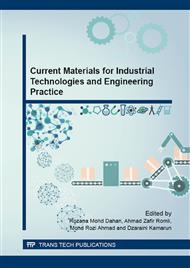p.147
p.154
p.160
p.165
p.171
p.178
p.185
p.191
p.198
High Modulus Rubber Vulcanizates from Natural Rubber/EVA Blends Filled with Reinforcing Fillers
Abstract:
The desired properties of rubber goods significantly depend on three key factors: 1) rubber formulations; 2) processing methods; and 3) design of products. High modulus rubber vulcanizates can hardly be achieved with a balance of the overall properties, because the rubbers or elastomers are soft and flexible material. In this research work, we aimed to formulate the natural rubber (NR) compounds for the specified high modulus rubber articles to be comparable with a slatted wood. Four important effects were taken into consideration, i.e. filler contents, amounts of process oil, blend ratios, and silane coupling agent contents. Based on the results in this study, the best possible combination to produce high modulus rubber vulcanizates was 80/20 NR/EVA blend reinforced by 60/60 silica/carbon black. The processing of compound can be aided by an addition of the process oil at 14.3 wt% relative to the filler contents and the silane coupling agent at 9.0 wt% relative to the silica amounts. The obtained rubber compound/vulcanizate showed easy processability, acceptable mechanical properties, and in particular hardness of 93 Shore A, while the slatted wood has 95 Shore A.
Info:
Periodical:
Pages:
171-177
Citation:
Online since:
December 2015
Price:
Сopyright:
© 2016 Trans Tech Publications Ltd. All Rights Reserved
Share:
Citation:


